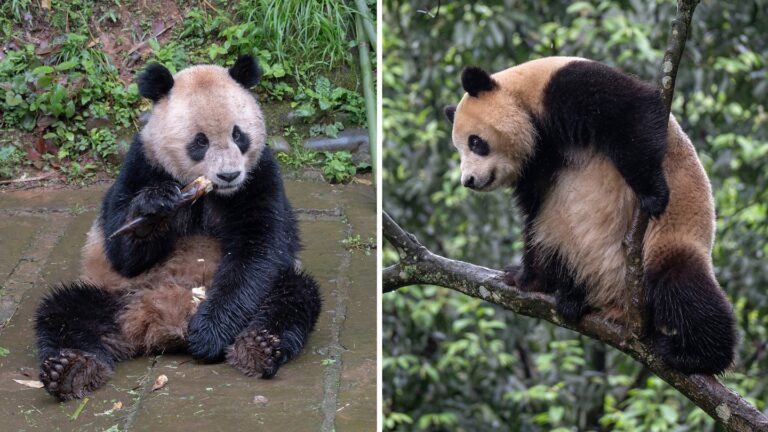Ahead of their big move, the pair attended a lavish farewell ceremony in China’s Sichuan province on Wednesday that was attended by U.S. and Chinese dignitaries, as well as San Diego Zoo Wildlife Alliance president and CEO Paul Barriboll and San Diego Mayor Todd Gloria.
The three-year-old female panda Xinbao is “calm and well-behaved”, while the four-year-old male panda Yunchuan is “intelligent and active”, the China Conservation and Research Center for the Giant Panda said in a statement, adding that the pair will enjoy “carefully prepared fresh bamboo, bamboo shoots, fruits, vegetables and special steamed buns” during the flight.
The pair will also be accompanied by several experienced nutritionists and veterinarians, and Chinese experts will stay with the zoo for around three months to help with the pair’s quarantine and adaptation period, the center said.
Officials from both countries said the relocation was part of ongoing efforts to protect the mammals. Pandas are no longer endangered, but remain vulnerable, according to the World Wildlife Fund.
The animals are also popular in U.S. zoos and have long been linked to China’s diplomatic efforts.
China is the only natural habitat for giant pandas, and panda diplomacy dates back to 685 AD. Since then, pandas have been sent to countries around the world as strategic goodwill ambassadors, seeking to soften China’s image abroad. In recent decades, China has loaned out giant pandas on a fee-paying 10-year contract, with cubs born overseas being returned to China before they turn four years old.
Pandas often become celebrities in the process: The departure of three pandas from the Smithsonian’s National Zoo in Washington last year sparked tearful farewells and fears that America might lose them altogether.
Leaders from the San Diego Zoo Wildlife Alliance joined prominent Chinese government officials and conservation leaders at a farewell ceremony honoring Yun Chuan and Xin Bao, two giant pandas who will be coming to the San Diego Zoo. pic.twitter.com/u16ujsIjU0
— San Diego Zoo Wildlife Alliance (@sandiegozoo) June 26, 2024
According to the San Diego Wildlife Alliance, Yun Chuan is the son of Zhen Zhen, who was born at the San Diego Zoo in 2007.
The alliance said the pandas will be given “several weeks” to get used to their new environment before being released to the public, and that once medical teams have deemed the pandas ready for public release, the zoo will share information about how the two pandas will be released.
WWF estimates that just 1,860 giant pandas remain in the wild, facing threats including climate change, dwindling food supplies and habitat fragmentation.
“Despite improvements in giant panda conservation, much work remains to be done to keep the population healthy and thriving on the path to recovery,” the statement said.
Chinese wildlife officials said the loan of the two pandas opens a new circle of cooperation in panda conservation between the United States and China. The China Wildlife Conservation Society added that it hopes conservation efforts between the two countries will lead to improved panda disease control and also promote “friendship between Chinese and overseas peoples.”
San Diego isn’t the only place eagerly awaiting a panda birth.
The Smithsonian’s National Zoo announced last month that two new giant pandas would arrive in Washington later this year. The move came as a surprise because all giant pandas in U.S. zoos are owned or leased by China and there are tensions between the U.S. and China, The Washington Post reported at the time.
In fact, Chinese pandas are so popular in Washington that one Chinese ambassador once joked, “Not many people realize this, but there are actually two Chinese ambassadors in Washington: myself and the baby panda at the National Zoo.”

